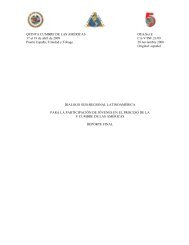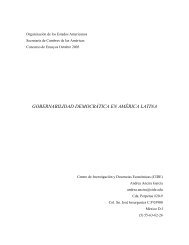The Road to Hemispheric Cooperation: Beyond the Cartagena
The Road to Hemispheric Cooperation: Beyond the Cartagena
The Road to Hemispheric Cooperation: Beyond the Cartagena
You also want an ePaper? Increase the reach of your titles
YUMPU automatically turns print PDFs into web optimized ePapers that Google loves.
<strong>the</strong> demand for innovation. Policies were designed without<br />
participation from <strong>the</strong> main stakeholders and based on <strong>the</strong><br />
assumption that research would follow a “linear path” from<br />
universities or research centers <strong>to</strong> adoption in production<br />
methods. This <strong>to</strong>p-down policy approach changed in <strong>the</strong><br />
1990s when emphasis was placed on demand fac<strong>to</strong>rs, and<br />
<strong>the</strong> intent was a “hands-off science and technology policy.”<br />
Public intervention was limited <strong>to</strong> correcting market failures<br />
and allowing private-sec<strong>to</strong>r demand <strong>to</strong> guide knowledge<br />
and technology activities. On balance, however, <strong>the</strong> model<br />
is considered <strong>to</strong> have been more successful in dismantling<br />
<strong>the</strong> previous <strong>to</strong>p-down approach ra<strong>the</strong>r than in designing<br />
<strong>the</strong> needed incentives <strong>to</strong> increase demand for innovation<br />
and technology.<br />
Technology policy has gradually evolved. Nowadays, <strong>the</strong><br />
prevailing approach is based on a recognition of complementarity<br />
between <strong>the</strong> public and private sec<strong>to</strong>rs in generating<br />
and disseminating knowledge. This systemic approach<br />
privileges interaction between supply and demand. Incentives<br />
for innovation have a sec<strong>to</strong>ral focus and are designed<br />
with involvement of <strong>the</strong> private sec<strong>to</strong>r. 16<br />
Over <strong>the</strong> past decade, several countries of <strong>the</strong> region have<br />
undertaken institutional reforms geared <strong>to</strong>ward streng<strong>the</strong>ning<br />
science and technology and innovation processes. Institutions<br />
responsible for designing innovation policy have grown<br />
stronger in several countries. <strong>The</strong> creation of ministries and<br />
agencies dedicated <strong>to</strong> innovation strategies illustrates <strong>the</strong><br />
growing interest in <strong>the</strong> design and implementation of more<br />
efficient and effective policies. To name but a few, Argentina<br />
created <strong>the</strong> Ministry of Science, Technology and Productive<br />
Innovation (2007); Chile established <strong>the</strong> National Innovation<br />
Council for Competitiveness (2005) and <strong>the</strong> Governmental<br />
(ministerial) Committee for Innovation for Competitiveness<br />
(2007), among o<strong>the</strong>rs. Since 2008, Brazil has implemented a<br />
productive development policy with strong participation from<br />
<strong>the</strong> Brazilian Development Bank (BNDES).<br />
<strong>The</strong> new strategic vision and institutional framework has<br />
been accompanied by new and diversified policy instruments<br />
geared <strong>to</strong>ward mobilizing resources for technological<br />
advance. No doubt, as <strong>the</strong> experience of countries that<br />
have been successful in invention and innovation shows,<br />
<strong>the</strong> production of new technological knowledge increases<br />
as more resources are committed <strong>to</strong> it. However, as Lam-<br />
oreaux and Sokoloff maintain in <strong>the</strong>ir study of innovation in<br />
<strong>the</strong> U.S. economy, it appears that <strong>the</strong>re is no globally superior<br />
way <strong>to</strong> organize <strong>the</strong> mobilization of resources for invention.<br />
<strong>The</strong>y also show that <strong>the</strong> way in which financing takes<br />
place has consequences for <strong>the</strong> direction of technological<br />
developments and <strong>the</strong> competitiveness of <strong>the</strong> economy. 17<br />
In Latin America, new policy instruments have included<br />
technology funds, sec<strong>to</strong>r-specific funds, venture capital incentives,<br />
and initiatives <strong>to</strong> promote university-enterprise cooperation,<br />
among o<strong>the</strong>rs. Funds are one of <strong>the</strong> most widely<br />
used <strong>to</strong>ols for encouraging enterprise knowledge generation.<br />
<strong>The</strong>re are basically two fund models in use in <strong>the</strong> region.<br />
<strong>The</strong>y differ in terms of how <strong>the</strong>y work, where <strong>the</strong> funding<br />
comes from, how <strong>the</strong> beneficiaries can tap <strong>the</strong>m, who<br />
is eligible, and how <strong>the</strong> funds are managed and moni<strong>to</strong>red.<br />
<strong>The</strong> Brazilian model takes an integrated approach, mixing<br />
elements of supply and demand and thus setting itself apart<br />
from <strong>the</strong> model that is more widely used in <strong>the</strong> region, which<br />
stresses demand.<br />
However, policies focused on national innovation systems<br />
and adequate financial support for implementing innovation<br />
strategies still need fur<strong>the</strong>r streng<strong>the</strong>ning. It remains necessary<br />
<strong>to</strong> improve planning capacity, overcome <strong>the</strong> tendency<br />
of assigning resources based on short-term assessments,<br />
and design more results-oriented policies.<br />
Increasing <strong>Cooperation</strong> on Innovation<br />
Today, science, technology and innovation occupy an important<br />
place in <strong>the</strong> agenda of several governments in <strong>the</strong><br />
region. Innovation is an increasingly integrated process<br />
that takes place over networks and requires <strong>the</strong> interaction<br />
and cooperation of various agents in both <strong>the</strong> public<br />
and private sec<strong>to</strong>rs. Streng<strong>the</strong>ning mechanisms <strong>to</strong> support<br />
regional cooperation on science, technology and innovation<br />
policies can prove key <strong>to</strong> generating synergies and<br />
complementarities. <strong>The</strong> scope of <strong>the</strong>se tasks tends <strong>to</strong> exceed<br />
national capacities; international cooperation is an<br />
important alternative that can enable countries <strong>to</strong> combine<br />
<strong>the</strong>ir efforts <strong>to</strong> attain <strong>the</strong> levels of quality, scale and productivity<br />
required in <strong>the</strong> global economy.<br />
<strong>The</strong> countries of Latin America and <strong>the</strong> Caribbean have accumulated<br />
experiences and capacities in managing policies<br />
<strong>to</strong> support scientific and technological development and in-<br />
<strong>The</strong> <strong>Road</strong> <strong>to</strong> <strong>Hemispheric</strong> <strong>Cooperation</strong>: <strong>Beyond</strong> <strong>the</strong> <strong>Cartagena</strong> Summit of <strong>the</strong> Americas<br />
<strong>The</strong> Brookings Institution ❘ Latin America Initiative<br />
17








